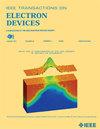A Novel MEMS Microwave Power Detection Chip Based on Multibeam Structure
IF 2.9
2区 工程技术
Q2 ENGINEERING, ELECTRICAL & ELECTRONIC
引用次数: 0
Abstract
In order to effectively improve the sensitivity performance of micro-electromechanical system (MEMS) microwave power detection chips, a MEMS microwave power detection chip based on a multibeam structure is proposed in this work. A four-beam parallel structure is designed, and the output capacitance of the chip is increased, thereby enhancing its sensitivity. The risk of collapse associated with excessively long single beams is also mitigated, reducing the occurrence of adhesion. The sensitivity and microwave performance of the chip have been theoretically studied, and the chip has been fabricated and measured. Measured results show that in the range from 8 to 12 GHz, the results of一种基于多波束结构的MEMS微波功率检测芯片
为了有效提高微机电系统(MEMS)微波功率检测芯片的灵敏度性能,本文提出了一种基于多波束结构的MEMS微波功率检测芯片。设计了四光束并联结构,增加了芯片的输出电容,从而提高了芯片的灵敏度。与超长单梁相关的倒塌风险也得到了缓解,减少了粘连的发生。对该芯片的灵敏度和微波性能进行了理论研究,并完成了芯片的制作和测试。实测结果表明,在8 ~ 12 GHz范围内,${S}_{{11}}$的结果范围为−18.5 ~−15.3 dB,而理论结果范围为−26.8 ~−25.2 dB。输入功率反射比偏差为1.2%。${S}_{{21}}$的实测结果范围为−3.6 ~−3.4 dB,而优化后的理论结果范围为−3.42 ~−2.27 dB,误差为1.8%。芯片的实测灵敏度为72.76 fF/W,而模型的理论值为73.5 fF/W,误差仅为1.01%。与现有结构相比,四梁并联结构的灵敏度最大提高了38.9倍,最小提高了1.4倍。因此,本文提出的基于多波束结构的MEMS微波功率检测芯片为提高灵敏度性能提供了有价值的参考。
本文章由计算机程序翻译,如有差异,请以英文原文为准。
求助全文
约1分钟内获得全文
求助全文
来源期刊

IEEE Transactions on Electron Devices
工程技术-工程:电子与电气
CiteScore
5.80
自引率
16.10%
发文量
937
审稿时长
3.8 months
期刊介绍:
IEEE Transactions on Electron Devices publishes original and significant contributions relating to the theory, modeling, design, performance and reliability of electron and ion integrated circuit devices and interconnects, involving insulators, metals, organic materials, micro-plasmas, semiconductors, quantum-effect structures, vacuum devices, and emerging materials with applications in bioelectronics, biomedical electronics, computation, communications, displays, microelectromechanics, imaging, micro-actuators, nanoelectronics, optoelectronics, photovoltaics, power ICs and micro-sensors. Tutorial and review papers on these subjects are also published and occasional special issues appear to present a collection of papers which treat particular areas in more depth and breadth.
 求助内容:
求助内容: 应助结果提醒方式:
应助结果提醒方式:


